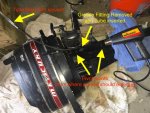- Joined
- Jul 18, 2011
- Messages
- 17,696
The steering swivel on my 1969 Mercury 7.5 HP outboard has been stiff for quite a few years. I have done the greasing thing . . . heated up the area to try to loosen the grease up and get it to flow, etc. but it still stiffens back up after a short while.
This year the steering won't even move . . . so I think I may have to dis-assemble, clean/repair, re-assemble the steering pivot assembly (or what ever it is called). I have looked online for the various part illustrations, videos, etc, and it looks like getting to the steering pivot can be quite involved.
How do you get to the pivot for dis-assembly purposes?
Does it require substantial dis-assembly of the engine/housing? or is there an easier way?
Serial number = 2634XXX (1969)
I tried to grease the pivot yesterday, but the grease gun had so much back pressure (from the seized pivot) that it could not force any more grease into the housing. I was thinking of removing the grease zerk and trying to work a solvent into the pivot assembly/housing to loosen things up :noidea:
This year the steering won't even move . . . so I think I may have to dis-assemble, clean/repair, re-assemble the steering pivot assembly (or what ever it is called). I have looked online for the various part illustrations, videos, etc, and it looks like getting to the steering pivot can be quite involved.
How do you get to the pivot for dis-assembly purposes?
Does it require substantial dis-assembly of the engine/housing? or is there an easier way?
Serial number = 2634XXX (1969)
I tried to grease the pivot yesterday, but the grease gun had so much back pressure (from the seized pivot) that it could not force any more grease into the housing. I was thinking of removing the grease zerk and trying to work a solvent into the pivot assembly/housing to loosen things up :noidea:




















